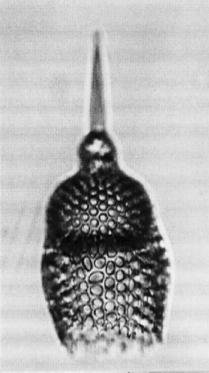 Calocycletta
(Calocycletta) robusta Moore
Calocycletta
(Calocycletta) robusta Moore Calocycletta
(Calocycletta) robusta Moore
Calocycletta
(Calocycletta) robusta MooreCalocycletta robusta Moore, 1971, p.743, p.10, figs.5-6
Stout conical apical horn that envelopes or nearly envelopes an ovate, lobed cephalis. Cephalis has very sparse subcircular pores. Thorax robust and hemispherical to subspherical in shape. Rough surface of the thorax contains circular, hexagonally arranged pores with a tendency towards longitudinal alignment. Lumbar stricture usually not marked externally (except in early forms). Abdomen tapers distally and contains subcircular pores that are strongly longitudinally aligned. Abdominal termination usually ragged, but may end in irregular lamellar and tapering feet in the later forms (Moore, 1971).
Based on 30 specimens. Length of apical horn 80-185 µm; of cephalis 34-48 µm; of thorax 73-144 µm; of abdomen 64-120 µm; of feet (when present) 16-48 µm. Breadth of cephalis 40-56 µm; of thorax 120-178 µm; of abdomen (distal) 64-96 µm (Moore, 1971).
This species is distinguished from Calocycletta parva by the heavier shell of C. robusta (particularly the abdomen), the more regular shape and arrangements of the abdominal pores and the long, conical apical horn (Moore, 1972).
Later forms of C. robusta are distinguished from C. virginis by the presence in C. virginis of regularly spaced terminal feet that generally begin at the same level on the abdomen and are of approximately equal width and length. Hence, it is necessary to have complete specimens to distinguish between the two species. Similarly C. robusta can only be distinguished from C. serrata by the presence on the latter species of triangular terminal feet.
Early forms of C. robusta have a nearly hemispherical thorax, a cylindrical shape in the region of the lumbar stricture, and an abdomen that tapers distally. Later forms have a subspherical thorax that gives rise smoothly to the uniform taper of the abdomen at or slightly above the lumbar stricture (Moore, 1971).
This species is a prominent constituent of assemblages from latitudes lower than 40° and ranges from the upper part of the Dorcadospyris ateuchus Zone to the Lychnocanoma elongata Zone.
Descendant of Calocycletta parva and ancestor of Calocycletta virginis and Calocycletta serrata.
For generic level phylogeny see Sanfilippo and Riedel, 1992, p.28.